CHEVROLET EXPRESS 1996 1.G Owners Manual
Manufacturer: CHEVROLET, Model Year: 1996, Model line: EXPRESS, Model: CHEVROLET EXPRESS 1996 1.GPages: 376, PDF Size: 18.83 MB
Page 201 of 376
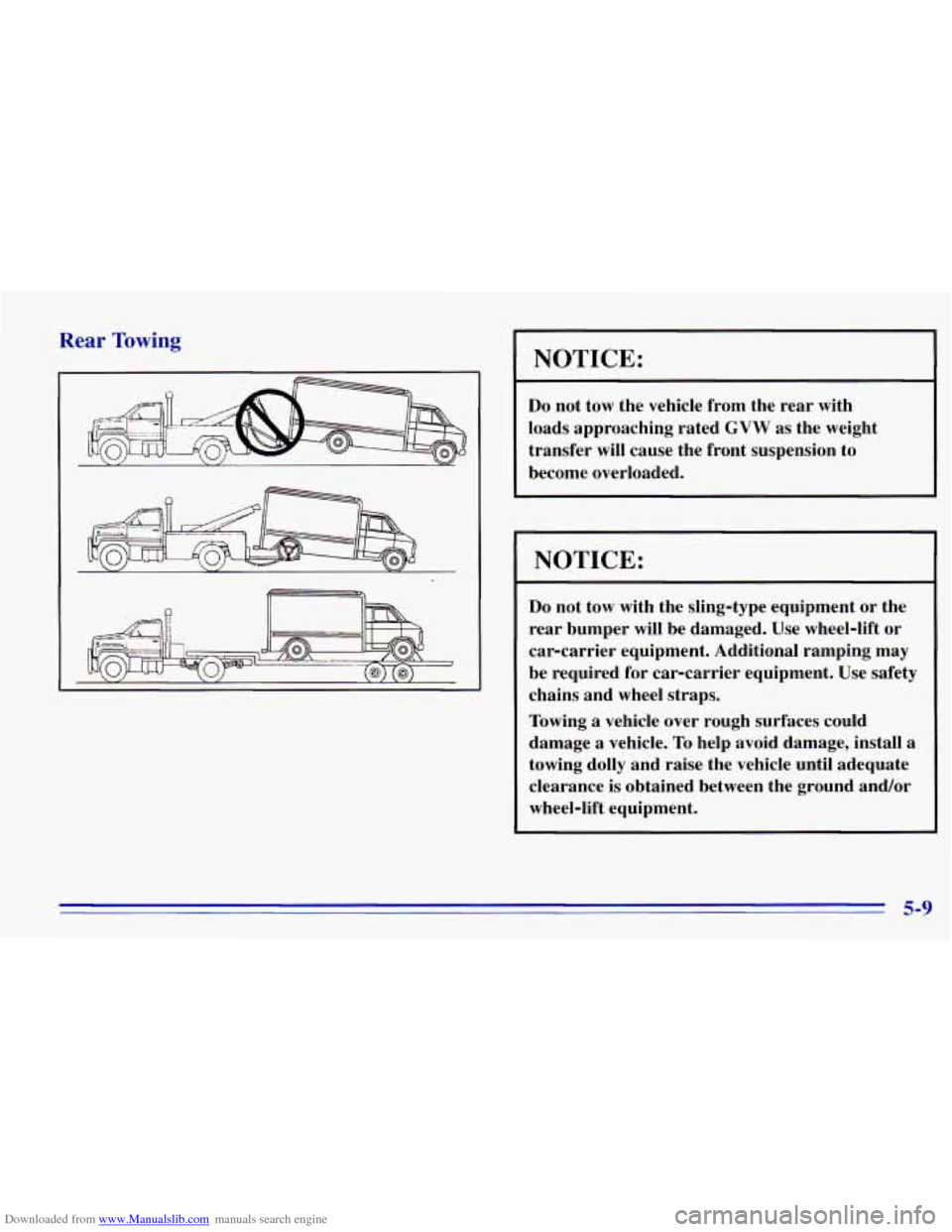
Downloaded from www.Manualslib.com manuals search engine Rear Towing
NOTICE:
Do not tow the vehicle from the rear with
loads approaching rated
GVW as the weight
transfer will cause the front suspension to
become overloaded.
NOTICE:
Do not tow with the sling-type equipment or the
rear bumper will be damaged. Use wheel-lift
or
car-carrier equipment. Additional ramping may
be required for car-carrier equipment. Use safety
chains and wheel straps.
Towing a vehicle over rough surfaces could
damage
a vehicle. To help avoid damage, install a
towing dolly and raise the vehicle until adequate
clearance is obtained between the ground and/or
wheel-lift equipment.
5-9
Page 202 of 376
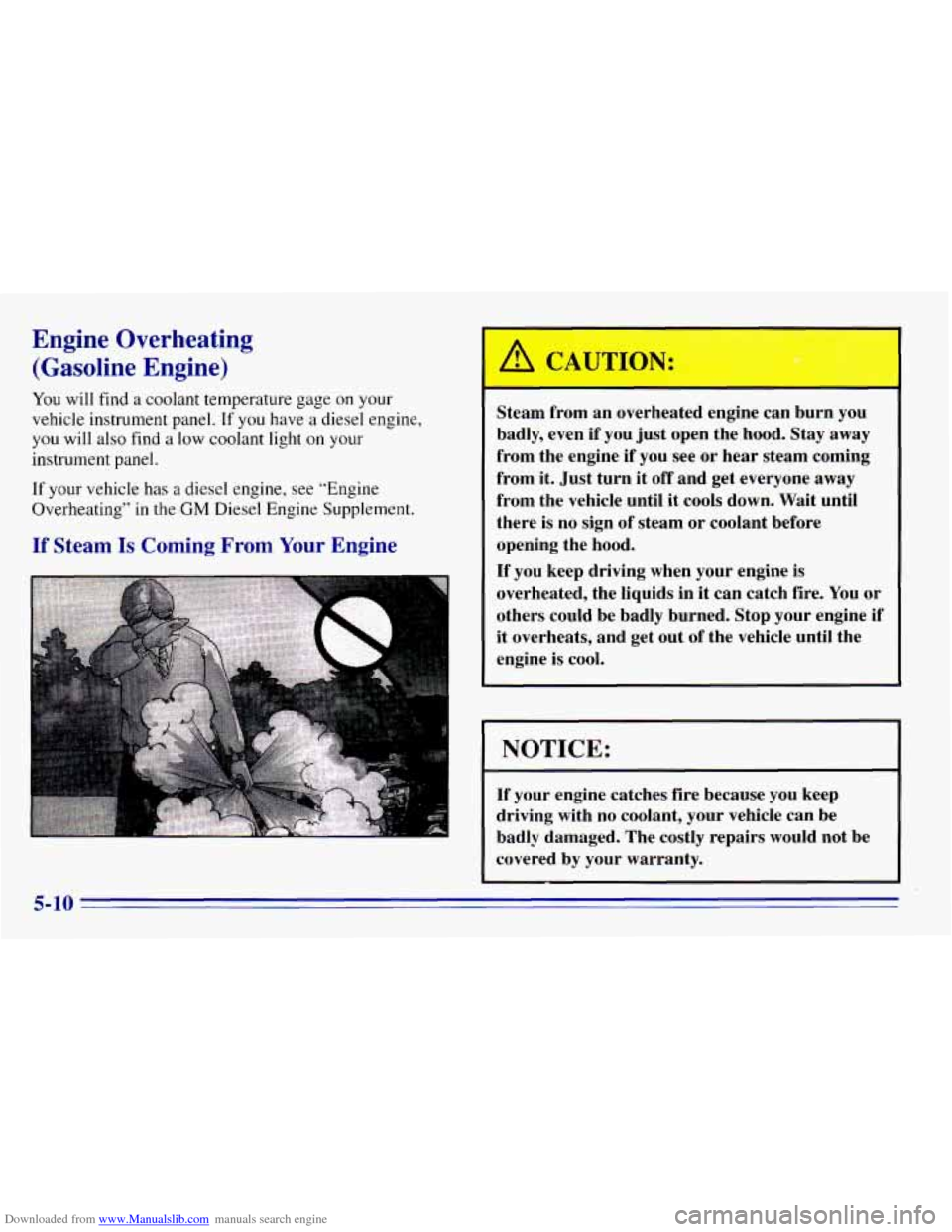
Downloaded from www.Manualslib.com manuals search engine Engine Overheating (Gasoline Engine)
You will find a coolant temperature gage on your
vehicle instrument panel.
If you have a diesel engine,
you will also find a low coolant light
on your
instrument panel.
If your vehicle has a diesel engine, see "Engine
Overheating"
in the GM Diesel Engine Supplement.
If Steam Is Coming From Your Engine
--- - >?.
Steam from an overheated engine can burn you
badly, even if you just open the hood. Stay
away
from the engine if you see or hear steam coming
from it. Just turn it
off and get everyone away
from the vehicle until it cools down. Wait until
there is no sign of steam or coolant before
opening the hood.
If you keep driving when your engine is
overheated, the liquids in it can catch fire. You or
others could be badly burned. Stop your engine if
it overheats, and get out of the vehicle until the
engine is cool.
NOTICE:
If your engine catches fire because you keep
driving with no coolant, your vehicle can be
badly damaged. The costly repairs would not be
covered
by your warranty.
5-10
Page 203 of 376
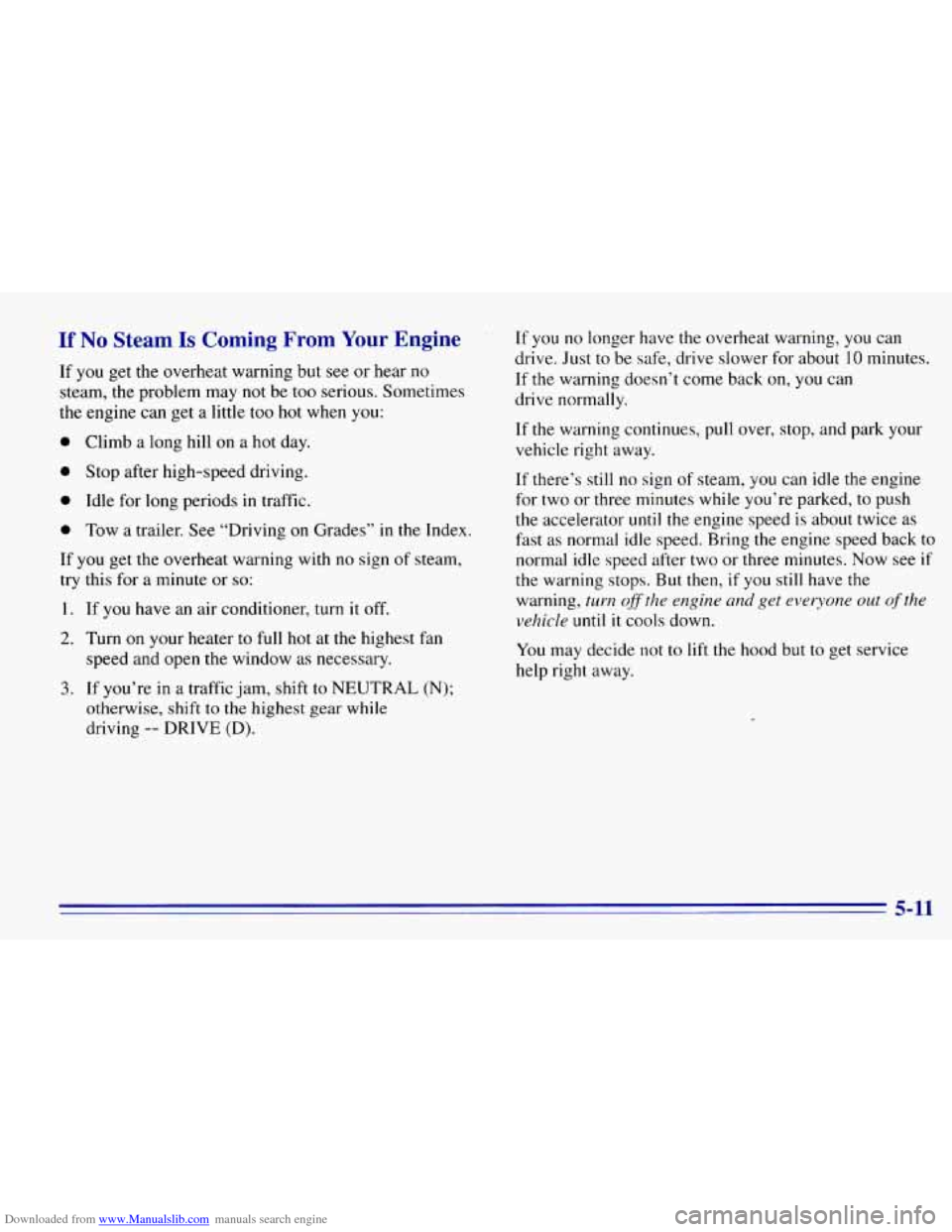
Downloaded from www.Manualslib.com manuals search engine If No Steam Is Coming From Your Engine
If you get the overheat warning but see or hear no
steam, the problem may
not be too serious. Sometimes
the engine can get a little too hot when you:
0 Climb a long hill on a hot day.
0 Stop after high-speed driving.
0 Idle for long periods in traffic.
0 Tow a trailer. See “Driving on Grades” in the Index.
If
you get the overheat warning with no sign of steam,
try this for a
minute or so:
1. If you have an air conditioner, turn it off.
2. Turn on your heater to full hot at the highest fan
speed and open the window as necessary.
3. If you’re in a traffic jam, shift to NEUTRAL (N);
otherwise, shift
to the highest gear while
driving
-- DRIVE (D).
If you no longer have the overheat warning, you can
drive. Just to be safe, drive slower for about
10 minutes.
If the warning doesn’t come back on,
you can
drive normally.
If the warning continues, pull over, stop, and park your
vehicle right away.
If there’s still no sign of steam, you can idle the engine
for two or three minutes while you’re parked,
to push
the accelerator until the engine speed is about twice as
fast as normal idle speed. Bring
the engine speed back to
normal idle speed after two or three minutes. Now see
if
the warning stops. But then, if you still have the
warning,
turn ofthe engine and get everyone out qf the
vehicle
until it cools down.
You may decide not to lift the hood but to get service
help right away.
5-11
Page 204 of 376
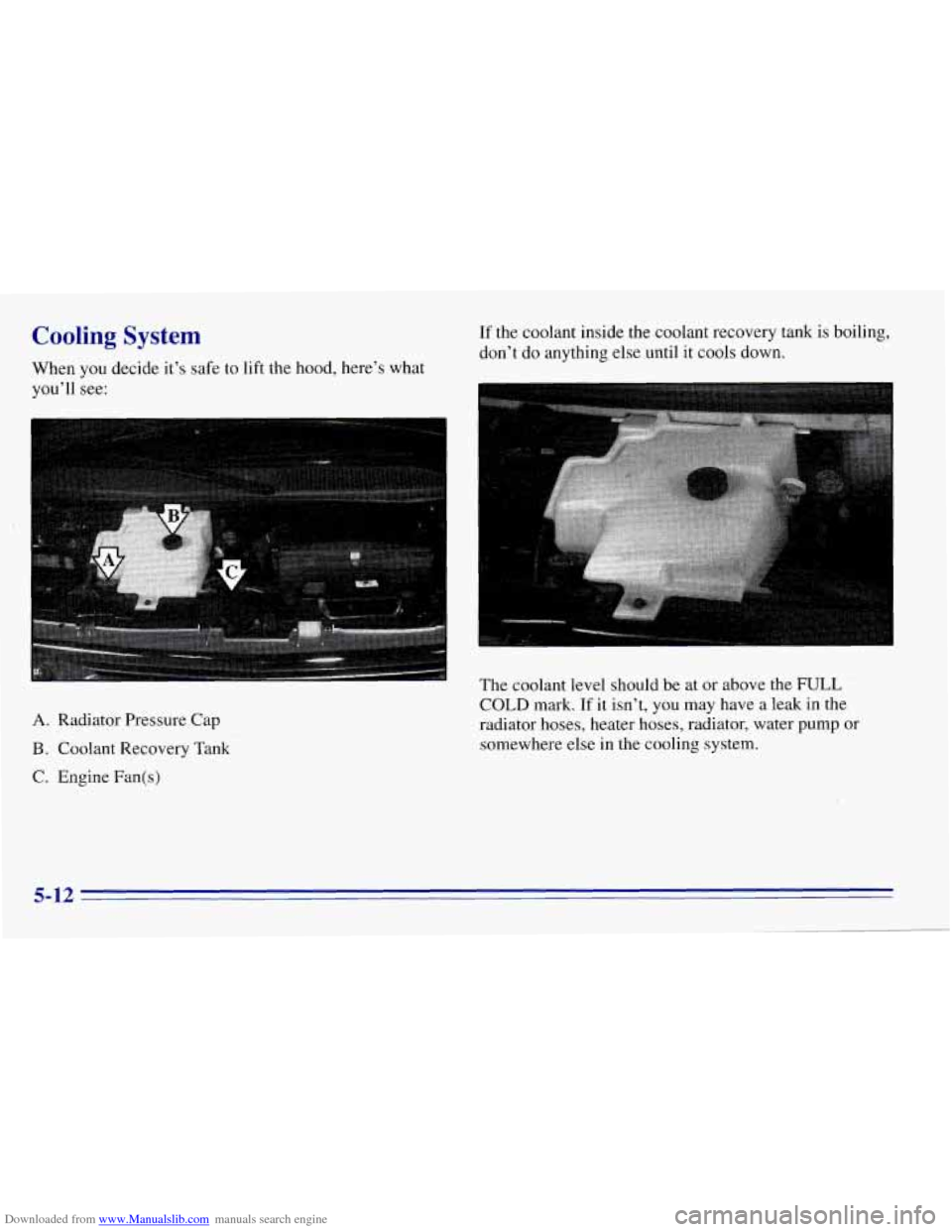
Downloaded from www.Manualslib.com manuals search engine Cooling System
When you decide it’s safe to lift the hood, here’s what
you’ll see:
A. Radiator Pressure Cap
B. Coolant Recovery Tank
C. Engine Fan(s)
If the coolant inside the coolant recovery tank is boiling,
don’t
do anything else until it cools down.
The coolant level should be at
or above the FULL
COLD mark.
If it isn’t, you may have a leak in the
radiator hoses, heater
hoses, radiator, water pump or
somewhere else in the cooling system.
5-12
Page 205 of 376
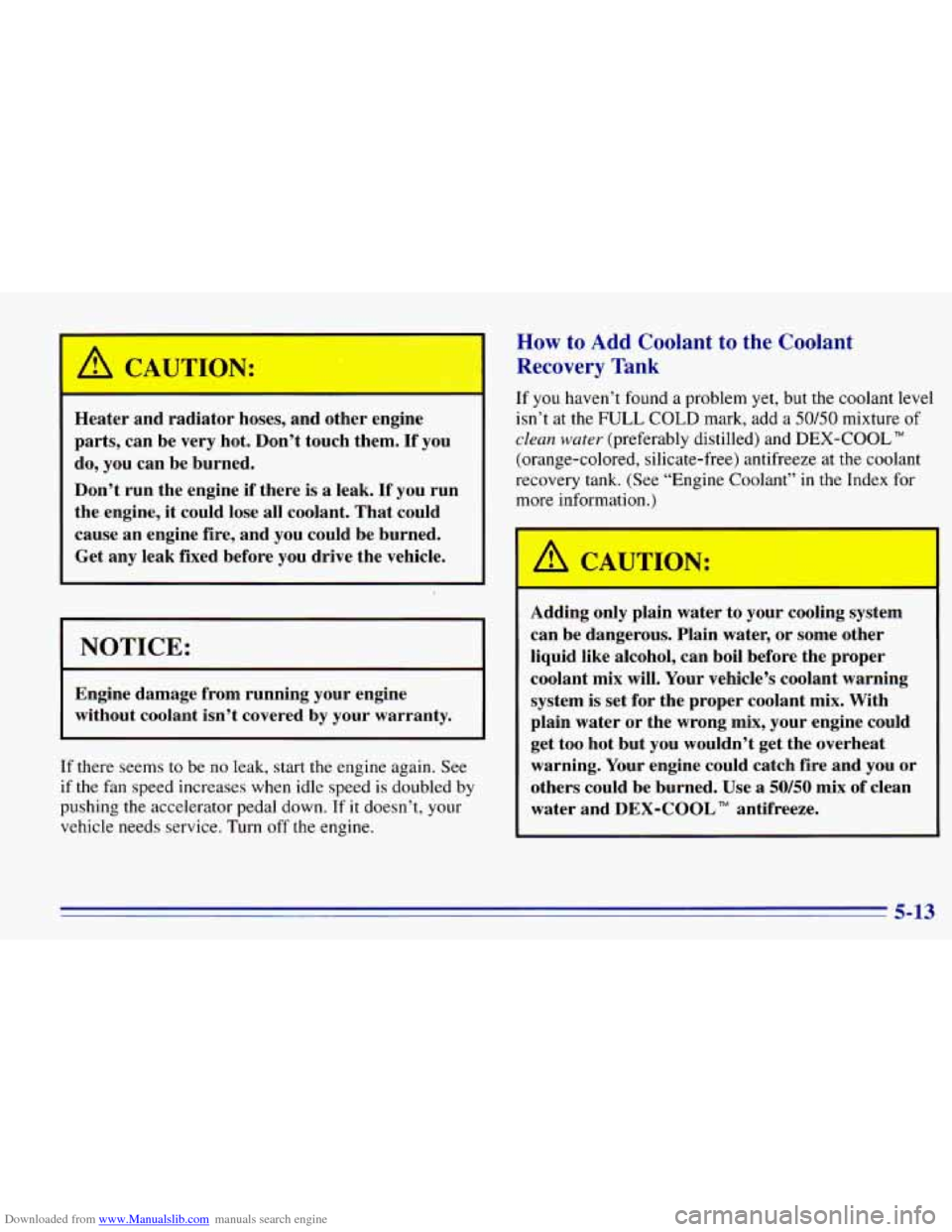
Downloaded from www.Manualslib.com manuals search engine A CAUTION:
Heater and radiator hoses, and other engine
parts, can be very hot. Don’t touch them. If you
do,
you can be burned.
Don’t run the engine if there is
a leak. If you run
the engine, it could lose
all coolant. That could
cause an engine fire, and you could be burned.
Get any leak fixed before you drive the vehicle.
NOTICE:
Engine damage from running your engine
without coolant isn’t covered
by your warranty.
If there seems to be no leak, start the engine again. See
if the fan speed increases when idle speed is doubled by
pushing the accelerator pedal down.
If it doesn’t, your
vehicle needs service. Turn
off the engine.
How to Add Coolant to the Coolant
Recovery Tank
If you haven’t found a problem yet, but the coolant level
isn’t at the FULL COLD mark, add a 5060 mixture of
clean water (preferably distilled) and DEX-COOL’”
(orange-colored, silicate-free) antifreeze at the coolant
recovery tank. (See “Engine Coolant”
in the Index for
more information.)
Adding only plain water to your cooling sy,,,m
can be dangerous. Plain water, or some other
liquid like alcohol, can boil before the proper
coolant mix will. Your vehicle’s coolant warning
system is set for the proper coolant mix. With
plain water or the wrong mix, your engine could
get too hot but you wouldn’t get the overheat
warning. Your engine could catch fire and you or
others could be burned. Use
a 50/50 mix of clean
water and DEX=COOL
TM antifreeze.
c 11
Page 206 of 376
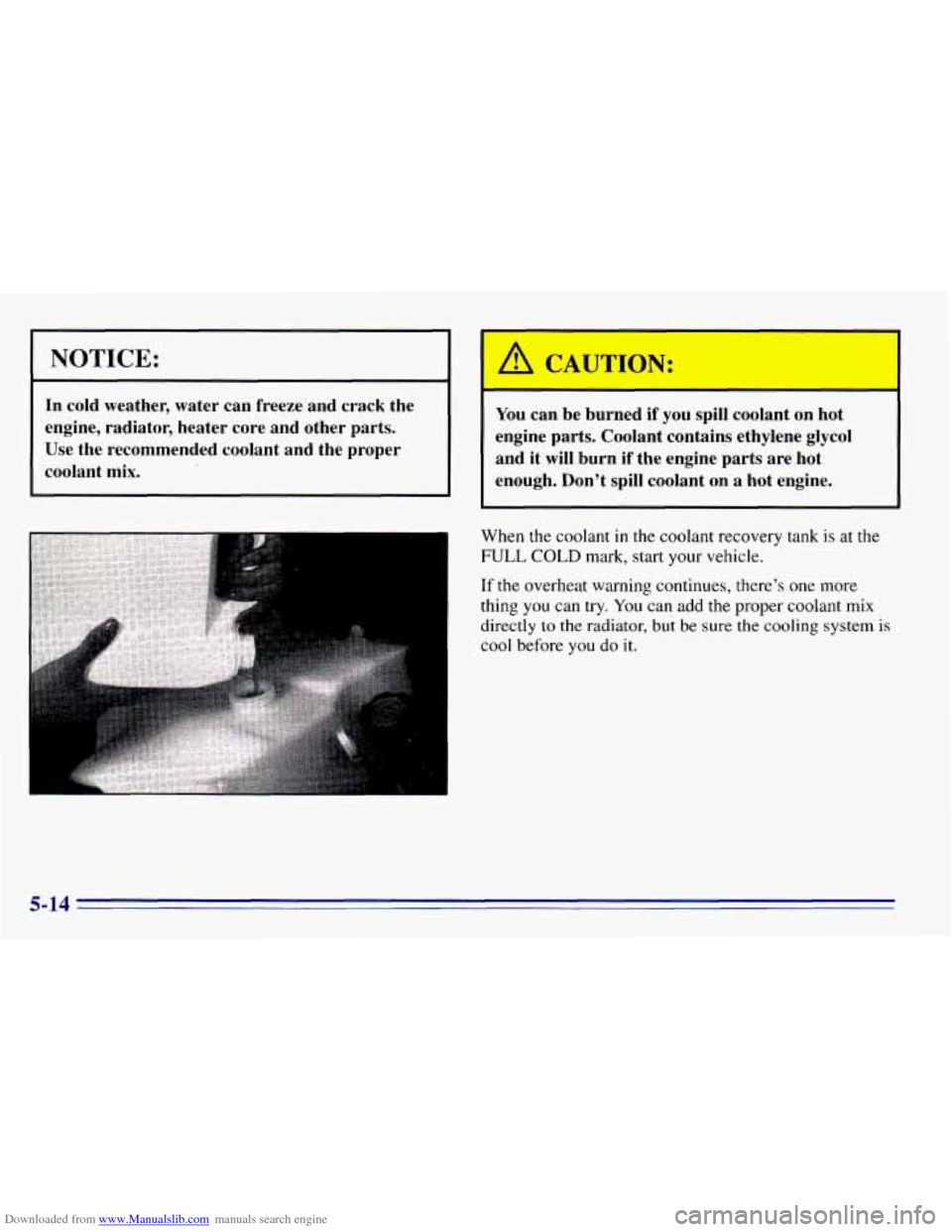
Downloaded from www.Manualslib.com manuals search engine I NOTICE:
~~
In cold weather, water can freeze and crack the
engine, radiator, heater core and other parts.
Use the recommended coolant and the proper
coolant mix.
A CAIJTION:
-
You can be b ed if you spill coolant on hot
engine parts. Coolant contains ethylene glycol
and it will burn if the engine parts are hot
enough. Don’t spill coolant on
a hot engine.
When the coolant in the coolant recovery tank is at the
FULL COLD mark, start your vehicle.
If the overheat warning continues, there’s one more
thing you can try. You can add the proper coolant mix
directly
to the radiator, but be sure the cooling system is
cool before you do it.
5-14
Page 207 of 376
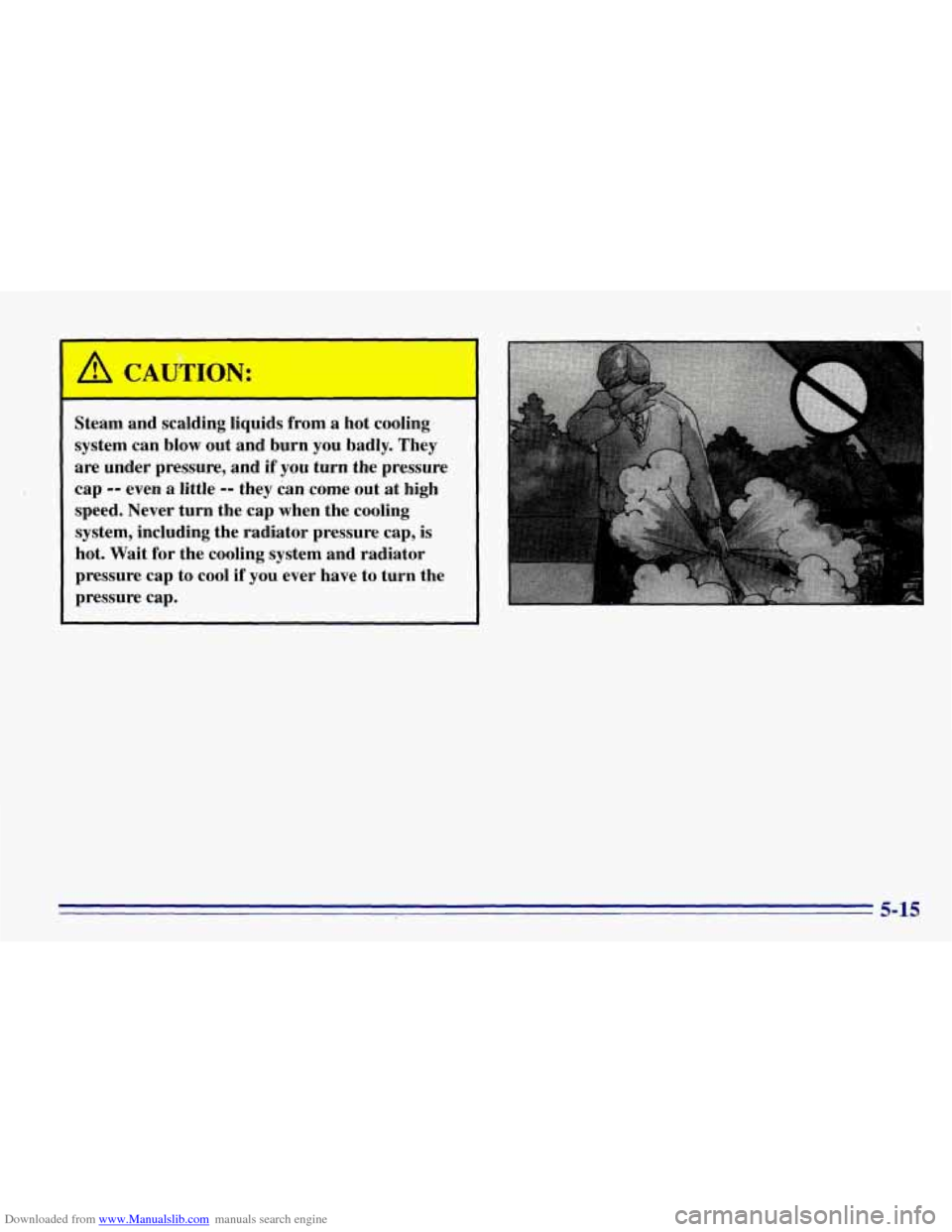
Downloaded from www.Manualslib.com manuals search engine Steam and scalding liquids from a hot cooling
system can blow out and burn you badly. They
are under pressure, and
if you turn the pressure
cap
-- even a little -- they can come out at high
speed. Never turn the
cap when the cooling
system, including the radiator pressure cap, is
hot. Wait for the cooling system and radiator
pressure cap to cool
if you ever have to turn the
pressure cap.
5-15
Page 208 of 376
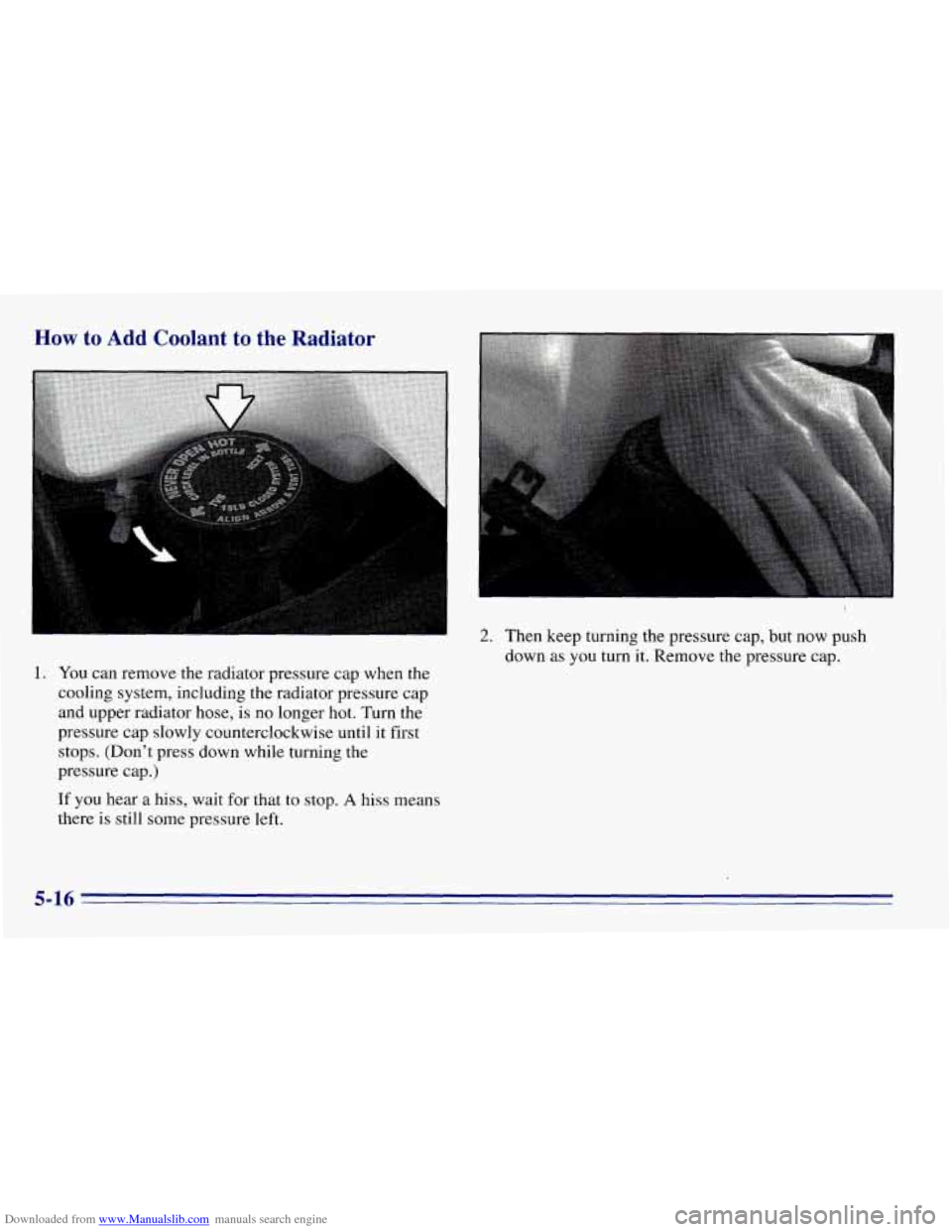
Downloaded from www.Manualslib.com manuals search engine How to Add Coolant to the Radiator
1. You can remove the radiator pressure cap when the
cooling system, including the radiator pressure cap
and upper radiator hose,
is no longer hot. Turn the
pressure cap slowly counterclockwise until it first
stops. (Don’t press down while turning the
pressure cap.)
If you hear a hiss, wait for that to stop. A hiss means
there is still some pressure left.
2. Then keep turning the pressure cap, but now push
down as you turn it. Remove the pressure cap.
5-16
Page 209 of 376
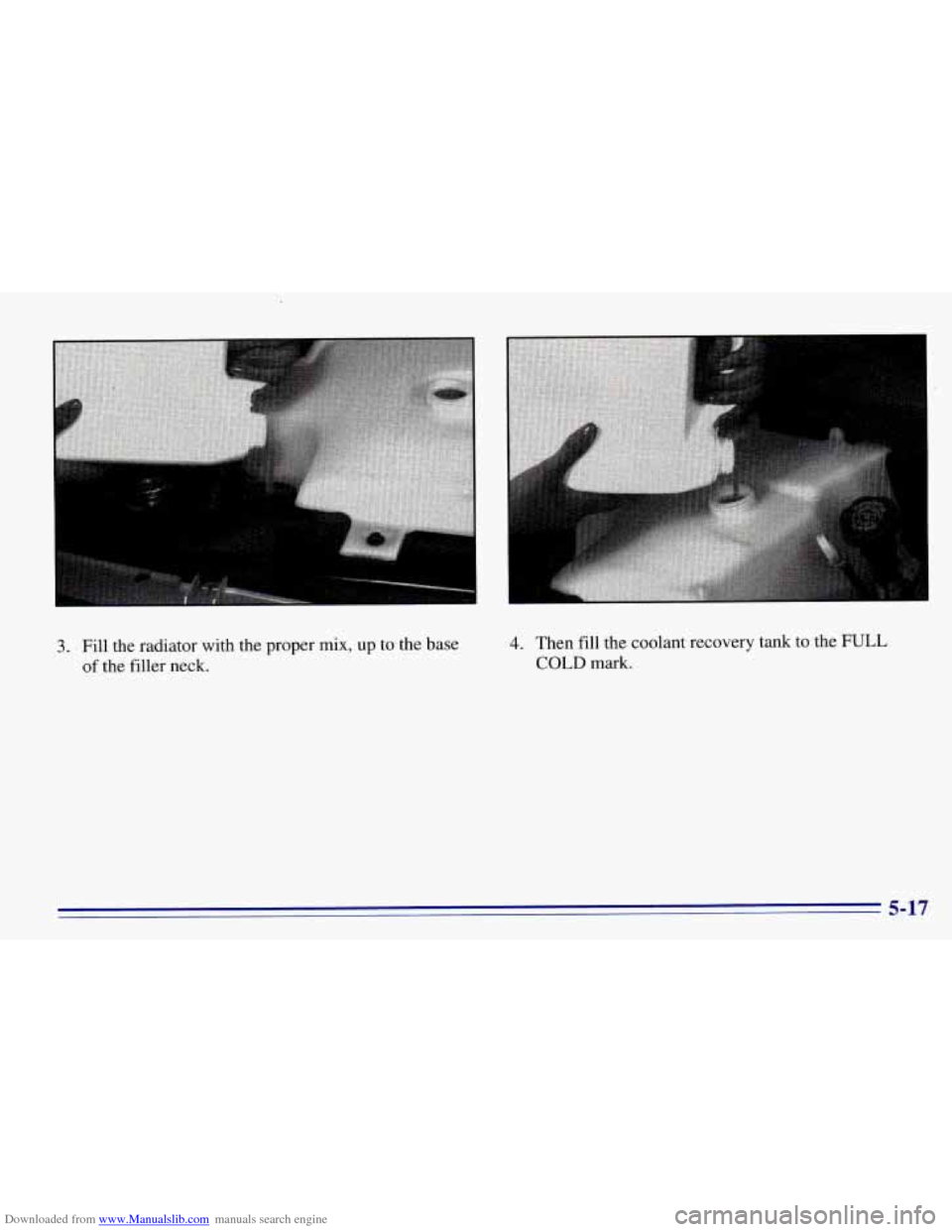
Downloaded from www.Manualslib.com manuals search engine I
3. Fill the radiator with the proper mix, up to the base
of the filler neck. 4. Then fill the coolant recovery tank to the FULL
COLD mark.
5-17
Page 210 of 376
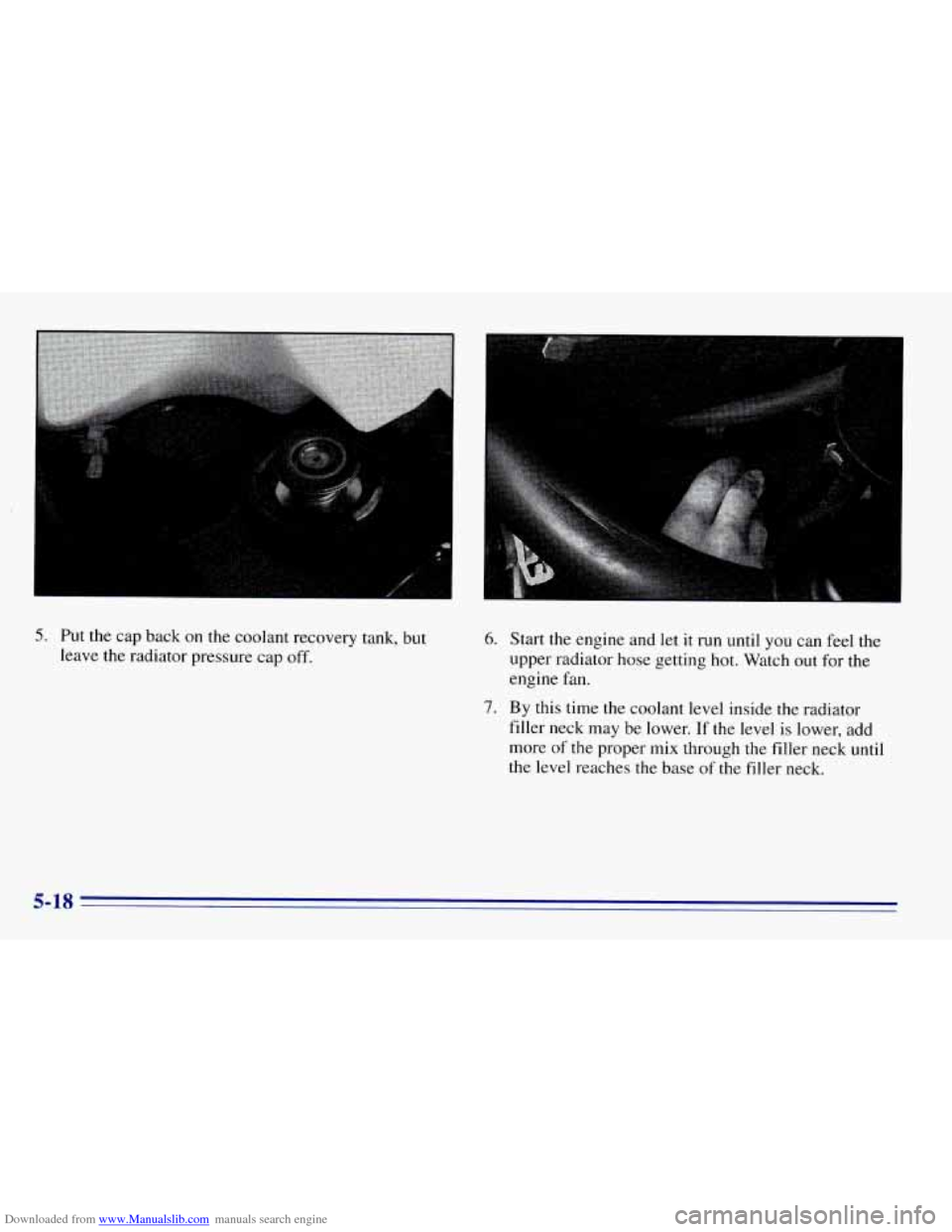
Downloaded from www.Manualslib.com manuals search engine 5. Put the cap back on the coolant recovery tank, but
leave
the radiator pressure cap off.
I
6. Start the engine and let it run until you can feel the
upper radiator hose getting hot. Watch out for the
engine fan.
7. By this time the coolant level inside the radiator
filler neck may be lower. If the level
is lower, add
more of the proper mix through the filler neck until
the level reaches the base of the filler neck.
5-18